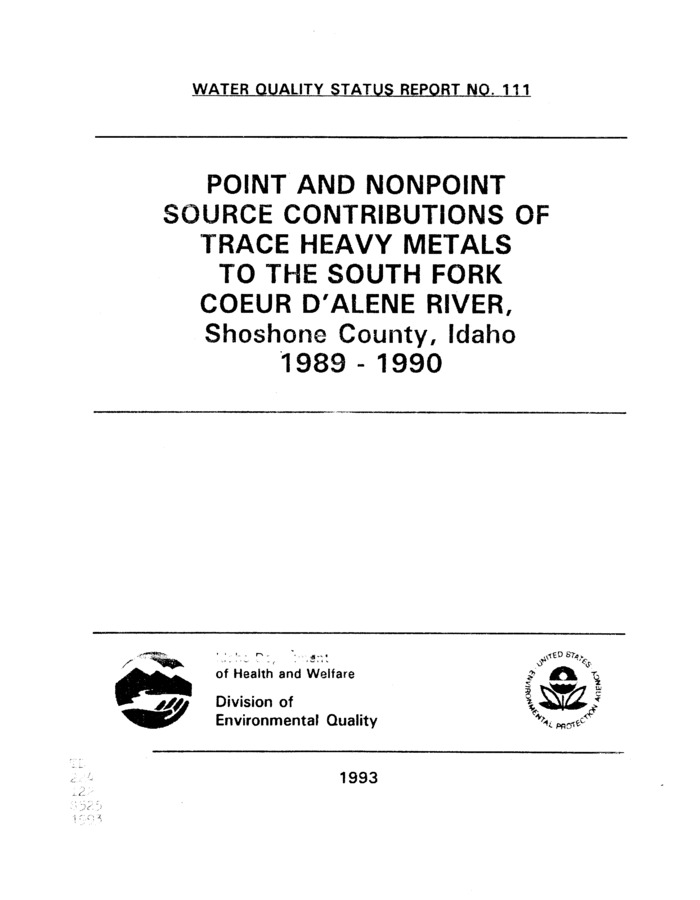PDF
Point and nonpoint source contributions of trace heavy metals to the South Fork Coeur d'Alene River, Shoshone County, Idaho 1989-1990. Water quality status report no. 111 Item Info
- Title:
- Point and nonpoint source contributions of trace heavy metals to the South Fork Coeur d'Alene River, Shoshone County, Idaho 1989-1990. Water quality status report no. 111
- Authors:
- Hartz, Mike
- Contributors:
- Idaho Water Resources Research Institute; IWRRI; Idaho Department of Health and Welfare, Division of Environmental Quality
- Date:
- 1993
- Description:
- This study was designed and implemented in an effort to determine the appropriateness of the 304 (I) listing of South Fork Coeur d'Alene River segment PB-130S. Section 304 (I) of the Water Quality Act of 1987 requires each state to list all stream segments that receive point source discharges of toxic pollutants and do not support appropriate beneficial uses even after effluent limitations are in place. In 1989 the U.S. Environmental Protection Agency (EPA) provided funding to the Idaho Division of Environmental Quality to assess the water quality and biotic integrity of the South Fork near Mullan, Idaho in Shoshone County. Water quality information was collected during the 1990 water year. The water chemistry and biological data were used to determine the support status of the beneficial uses and the relevance of the segment boundary listed in Idaho Water Quality Standards. Specific objectives of this study include the following: 1) determine point source and nonpoint source heavy metals contributions to the South Fork above the Morning District bridge near Mullan, Idaho; 2) determine the effect of heavy metals on aquatic life uses in the study reach; and 3) determine the relevance of the stream segment boundary between stream segments PB-130s and PB-140s. Metals loading to the South Fork above Mullan, Idaho was modest compared to other reaches within the drainage, as estimated by the 1989-1990 data. Nonpoint source additions were the primary source of heavy metals to the river above Mullan. Between 1989 and 1990 treated wastewater from Hecla's Lucky Friday mining operation generally contributed less than 3.0 % of the cadmium, copper and zinc load in the river. Lead contribution to the river from Hecla discharges were generally less than 9%, although low flow total lead contribution from pond 001 was estimated at 42% of the load at the lowest river station. Fish and benthic macroinvertebrate communities were assessed at all the river stations in the study area. Macroinvertebrate data analysis does not conclusively indicate impairment of the use at the sampling stations from point source additions. Fisheries data was insufficient to determine the effect of point source metals discharges on fish communities at the sampling sites. Due to equipment failures, proper fish collection procedures were not followed therefore, comparisons of population estimates between each sample station were unavailable. However, qualitative analysis of fisheries information do not suggest substantial differences in beneficial use support status throughout the study reach. Impairment of beneficial uses and/or water chemistry of a waterbody attributed to point source pollution discharges, should be demonstrated in order to warrant 304 (I) listing. The data do not support the 304 (I) listing of segment PB-130s since impairment of cold water biota is not apparent. In addition, water quality data indicate point source contributions of metals to the river in PB-130s are minor compared to nonpoint sources. Toxicological effects of metals on aquatic organisms (if any) in segment PB-130s cannot be attributed to point source additions within the scope of the current study design. The information generated in this study was also used to evaluate the appropriateness of the segment boundary location between segments PB-140S and PB-130s. The designated beneficial uses of segment PB-140s (lowermost) differ from the range of uses designated for segment PB-130S. The existence of such a boundary implies beneficial uses change and therefor water quality management changes at a given boundary. However, the observed appropriate beneficial uses do not change throughout the length of the study reach. The beneficial use of cold water biota and salmonid spawning are existing and attainable everywhere in the study reach. These data do not support placement of a segment boundary anywhere within the current study site. Reliable toxics criteria for cold water biota in the study site apparently are not available. This study documents exceedance of current chronic lead and zinc criteria without any observed effect, attributable to elevated metals concentration, on aquatic biota. This issue can be resolved through development of site specific criteria applicable to waters in the study area. Accurate site specific criteria should subsequently be applied to effluent limitations in order to protect aquatic life uses in the river.
- Subjects:
- heavy metals water pollution mine wastes
- Location:
- Coeur d'Alene River
- Idaho County:
- Shoshone County
- Latitude:
- 47.51
- Longitude:
- -116.15
- Collection:
- Coeur d'Alene Basin
- Source:
- Idaho Department of Health and Welfare, Division of Environmental Quality
- Publisher:
- Idaho Department of Health and Welfare, Division of Environmental Quality
- Contributing Institution:
- University of Idaho
- Type:
- Text
- Format:
- application/pdf
- Cataloger:
- wbv
- Date Digitized:
- 2012
- Language:
- eng
Source
- Preferred Citation:
- "Point and nonpoint source contributions of trace heavy metals to the South Fork Coeur d'Alene River, Shoshone County, Idaho 1989-1990. Water quality status report no. 111", Idaho Waters Digital Library, University of Idaho Library Digital Collections, https://www.lib.uidaho.edu/digital/iwdl/items/iwdl-cda_ideqhartz_1993.html
Rights
- Rights:
- In copyright, educational use permitted. Educational use includes non-commercial reproduction of text and images in materials for teaching and research purposes. For other contexts beyond fair use, including digital reproduction, please contact the University of Idaho Library Special Collections and Archives Department at libspec@uidaho.edu. The University of Idaho Library is not liable for any violations of the law by users.
- Standardized Rights:
- http://rightsstatements.org/vocab/InC-EDU/1.0/

